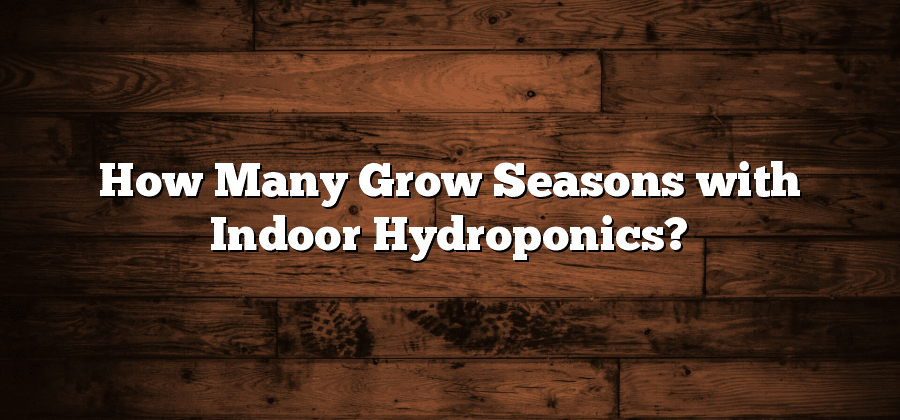Benefits of Indoor Hydroponics for Year-Round Cultivation
Hydroponics, the method of growing plants without soil, offers a multitude of benefits for year-round cultivation when practiced indoors. One of the most significant advantages is the ability to control and manipulate the growing environment. With traditional outdoor gardening, plant growth is heavily dependent on weather conditions and seasonal changes. In an indoor hydroponic system, however, growers have the power to regulate lighting, temperature, humidity, and nutrient levels, creating a consistent and optimal environment for plant growth throughout the year.
This control over the growing environment not only allows for continuous cultivation but also ensures healthier and more vigorous plants. By optimizing the growing conditions, indoor hydroponics eliminates the risk of pests, diseases, and weeds that outdoor gardens often face. Additionally, since plants receive a consistent supply of water and nutrients in a hydroponic system, they can grow faster and produce higher yields compared to traditional soil-based methods. As a result, indoor hydroponics provides the opportunity for year-round harvests, regardless of the season, maximizing productivity for small-scale gardeners and commercial growers alike.
Understanding the Growth Cycle of Hydroponic Plants
Hydroponic plants undergo a distinct growth cycle that is closely monitored and controlled by cultivators. Understanding this growth cycle is crucial for ensuring the plants receive the right conditions and care throughout their lifespan.
The growth cycle of hydroponic plants consists of four main phases: germination, vegetative growth, flowering, and fruiting. During the germination phase, seeds are soaked and sprouted before being transferred to the hydroponic system. Once the seedlings have developed roots, they enter the vegetative growth phase, where they focus on building strong foliage and root systems. This phase is characterized by rapid growth and an emphasis on leaf production. Growers must provide adequate lighting and nutrients to support healthy growth during this stage.
Optimizing Lighting and Temperature for Continuous Growth
Proper lighting and temperature control are fundamental factors in ensuring the continuous growth of hydroponic plants. Lighting plays a vital role in providing the necessary energy for photosynthesis. In an indoor hydroponic system, artificial lighting becomes crucial as it serves as a substitute for natural sunlight. LED lights are commonly used due to their energy efficiency and ability to generate the ideal spectrum of light for plant growth. It is recommended to position the lights directly above the plants, maintaining a distance of approximately 12 to 18 inches to facilitate optimal light absorption. Implementing a timer to regulate the lighting duration is also essential, as different plant species have varying light requirements.
Temperature is another critical aspect to consider for continuous growth in hydroponics. Each plant species has an ideal temperature range for optimal growth. Maintaining a consistent and appropriate temperature is vital to avoid stress and ensure plant health. Generally, a temperature range of 65 to 75 degrees Fahrenheit is suitable for most plants in hydroponic systems. However, it is essential to research the specific temperature requirements of the plants being cultivated and adjust accordingly. Proper ventilation and air circulation are also essential to control temperature, preventing it from becoming too high or too low. By tightly managing lighting and temperature, hydroponic growers can create an optimal environment that promotes continuous growth and maximizes the health and yield of their plants.
Choosing the Right Hydroponic System for Extended Cultivation
Hydroponics has gained popularity as an efficient and sustainable method for year-round cultivation. When it comes to extended cultivation, choosing the right hydroponic system is crucial for maximizing yields and ensuring consistent plant health. There are several factors to consider when selecting a system that suits your needs and goals.
First, determine the scale at which you plan to operate. Are you looking to set up a small-scale indoor garden or a larger commercial operation? The size of your hydroponic system will determine the type of equipment and infrastructure required. Consider the available space, budget, and time commitment you are willing to invest. Additionally, think about the types of plants you intend to grow, as certain systems may be better suited for specific crops.
Nutrient Management for Consistent Plant Health and Yield
Effective nutrient management is essential in maintaining consistent plant health and maximizing yield in hydroponic systems. Unlike traditional soil-based cultivation, where plants can extract nutrients from the surrounding soil, hydroponics relies on nutrient solutions to provide essential elements. These solutions must be carefully mixed to meet the specific needs of the plants being grown.
Balancing the nutrient mix is crucial to ensure that plants receive the right amounts of macronutrients such as nitrogen, phosphorus, and potassium, as well as micronutrients like iron, manganese, and zinc. Monitoring and adjusting the nutrient solution regularly is necessary to address any deficiencies or imbalances that may arise. This process requires meticulous attention to detail and a deep understanding of the nutritional requirements of different plant species.
Additionally, maintaining the appropriate pH level of the nutrient solution is paramount for optimal nutrient uptake. pH levels that are too high or too low can hinder the plants’ ability to absorb nutrients, leading to stunted growth or nutrient deficiencies. Regular testing and adjustment of the pH level are necessary to ensure that plants can efficiently access the nutrients they require for healthy development.
By prioritizing nutrient management in hydroponic systems, cultivators can not only promote consistent plant health but also enhance overall yield. As the understanding of plant nutrition in hydroponics continues to advance, new techniques and strategies are being developed to optimize nutrient delivery and maximize productivity. Implementing these advancements and constantly refining nutrient management practices will enable growers to achieve greater success in their year-round cultivation endeavors.






